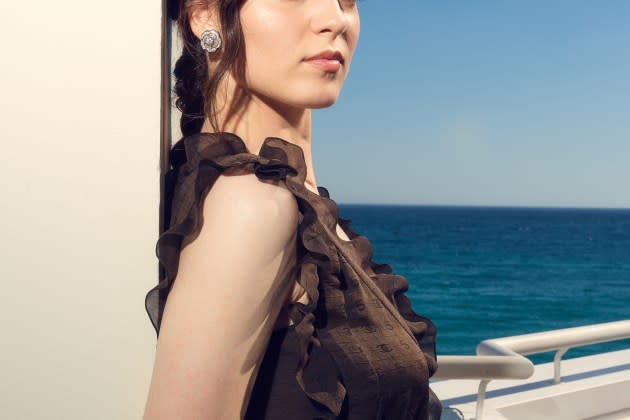French Actress Anamaria Vartolomei Experiences Two Very Different Premieres at Cannes

CANNES — It’s no small task to do double duty during the Cannes Film Festival, and it’s been an emotional roller coaster for French actress Anamaria Vartolomei.
She has premiered two vastly divergent films — and walked two red carpets in Chanel — with different emotional charges. “Being Maria” had its world premiere, as did “The Count of Monte Cristo.”
More from WWD
EXCLUSIVE: Dior Names 15 Female Athletes as Brand Ambassadors Ahead of Paris 2024 Games
Heidi Klum and Daughter Leni Bring Contrasting See-through Dresses to amfAR Cannes Gala 2024
“It’s two different worlds. It was the moon and the sun from one day to another,” Vartolomei says of the experience.
With “Being Maria,” the soft-spoken actress has received rave reviews for her delicate portrayal of “Last Tango in Paris” actress Maria Schneider.
Schneider was 19 when she took on what she thought would be a career-making role; instead a nonconsensual rape scene secretly planned by director Bernardo Bertolucci and star Marlon Brando broke her.
The reception to “Being Maria” was “quiet and full of so much love,” while the more blockbuster-style “Monte Cristo” was “joyous” with a 12-minute standing ovation.
“That’s what I wanted for the movie and for Maria,” Vartolomei says. “Her voice and what she wanted to share back then has been heard now.”
Then and Now
It’s not a biopic per se, but an adaptation of Schneider’s life, in which she spiraled into addiction. She died in 2011 at age 58.
The movie is very much about being thrust into the spotlight for all the wrong reasons.
“It’s about the gaze. She wanted people to stop looking at her because she felt the pressure. The way these people transformed her and the way she was very much sexualized. She has been reduced to her body and to the size of her breasts. I think that destroyed her,” Vartolomei says. “And it is also a movie about loneliness.”
Schneider tried to tell her story in a documentary in the 1970s, as well of how the male-dominated industry treated working actresses at that time. Her perspective was not taken seriously, and the infamous scene was treated as a joke. Bertolucci and Brando were both nominated for Oscars.
“She tried to tell these things without any reception. It was in vain,” she says. Vartolomei is well aware of the differences — and parallels — to now.
“Being Maria” comes as the French industry is dealing with its own #MeToo movement following accusations from actress Judith Godrèche accusing directors Jacques Doillon and Benoît Jacquot of sexual abuse when she was a teen.
“I think now it’s maybe too late to say sorry, too late to try to repair things for [Maria]. But I feel that it’s just as alarming that it still resonates with the news,” she says. Many have pointed out that it feels like a contemporary story in many ways, with the same issues of consent playing out.
“It’s important to tell her story — she was one of the first ones to talk openly about the abuse in the industry, and to sort of take off the taboo,” she says. “What now is changing is that we have a different reception of the testimonies of victims, we are more empathic, we give them more respect, which she didn’t have at that time. Now we have to say that the victims are not marginal.”
The Suit
Chanel contributed costumes to the film, and one in particular stands out for Vartolomei. It comes in the last scene where the character is dressed in a Chanel suit, which was from the fall 2023 ready-to-wear collection inspired by archival looks.
“It feel it’s empowering,” she says of the pantsuit. “This kind of suit is very strong and very thoughtful and very elegant. It raises Maria up. It is giving her her dignity back.”
It speaks to her long-standing relationship with the brand as a house ambassador. The brand can “fit any era and it will never seem old fashioned,” she believes. “It doesn’t take out my personality and I don’t feel like I am wearing something that is overpowering me. It goes the other way. I feel it gives me power to express myself the way that I am.”
It did the same for the character of Maria, she believes, which is why it worked on screen despite being contemporary.
She also wore Chanel on the red carpet for “Monte Cristo,” selecting a gauzy chocolate gown that resembled a costume she wore in the film.
The color was an unusual choice, but worked as a subtle nod to her character.
A Reeducation
The experience of working on “Monte Cristo,” opposite Pierre Niney, was much more lighthearted than “Maria.”
The Romania-born actress also enlisted her parents as dialect coaches. Having moved to France at age six, she does not have an accent in French. But since her character is supposed to be foreign, she used her parents’ lilt to inform how she approached the role.
The movie has been acquired by Samuel Goldwyn Films for U.S. distribution, so it will be coming to American screens soon.
There’s also her first English language role, which is completed but still under wraps, she says. That film is aiming for a January release in the States.
Filming in her third language was a challenge. “Acting in English is different. It’s not the same way of using the same rhythm. It’s not the same music or the words, and it was almost a reeducation of the language for me, understanding what the stress words are and stuff like that,” she says. “It was pretty hard, but it was a nice experience. And I hope it’s not the last.”
Best of WWD

 Yahoo Lifestyle
Yahoo Lifestyle 